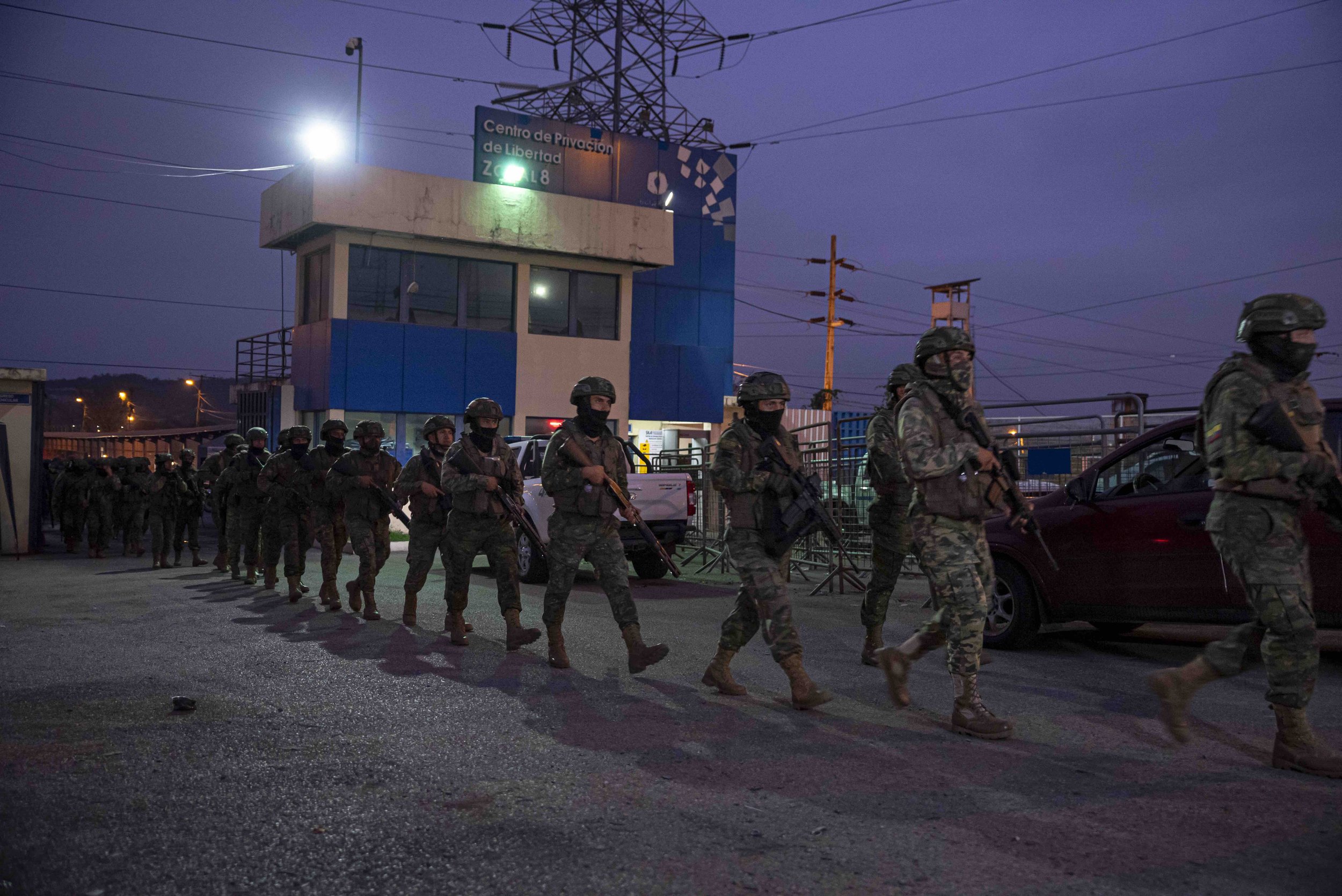Ecuador’s reactionary war
A group of soldiers arrives to Zone 8 Liberty Prison, in Guayaquil, Ecuador, on January 7, 2024, to search for alias ‘Fito,’ who escaped from the facility days earlier. Photo © Ojalá.
Opinion • Dawn Marie Paley • January 16, 2024 • Leer en castellano
Civil rights annulled. Soldiers in the streets, curfews enforced. Armed men in masks patrol neighborhoods. Packets of marijuana and boxes of money laid out and photographed. US State Department officials in formal dress shake hands with their local counterparts.
Ecuador has recently begun to experience a pattern of violence similar to that of Colombia over the last 25 years and Mexico over the last 15.
Government officials claim that those responsible for the violence in Ecuador are men in criminal gangs, now considered “terrorists,” with nicknames like “Cuyuyuyuy” and “El Ravioli.” In this context, we are told, the military is acting to disrupt organized crime and protect citizens.
Some suggest that a crime boss’s second escape from prison was the straw that broke the camel's back and that it required an immediate military response. This recalls the so-called escapes of Joaquín “El Chapo” Guzmán. Journalist Anabel Hernández writes that the first time, Guzmán was wheeled out of the front door of the prison in a laundry cart with the cooperation of the guards. In the second instance, he is said to have escaped from a tunnel that the press has never actually seen.
Just as we question official discourse about austerity policies and economic measures that justify extractivism and benefit the one percent, it is important to question the official discourse on violence and, in particular, militarization.
In Mexico, a similar kind of discourse has been in use since President Felipe Calderón took office in December 2006 and launched the “War on Drugs” there. I have written two books on the topic. Based on that work, I thought I would share some principles that help us make sense of what is taking place in Ecuador.
Official discourse about the Drug War generates confusion and tries to convince us that those with the least power are the most violent and dangerous. It conceals the role of governments in structuring the prohibition that creates banned substances and the subsequent militarization of public life.
In Ecuador, the prison system (in which more than 400 prisoners have been killed in the last three years) is a central node in the organization of war against the people, which is also a war against prisoners.
Three soldiers with their weapons stand guard as their colleagues enter the Zone 8 Liberty Prison in Guayaquil, Ecuador on January 9, 2024. Photo © Ojalá.
110 and 111
The content of Executive Decrees 110 and 111, published on January 8 and 9, illustrate how governments create confusion in the context of what has been known as the “War on Drugs” for decades now.
Decree 110 cites a National Police (PN, in its Spanish acronym) report that alleges that 91 percent of the 8,008 homicides committed last year "are attributed to criminal violence, which is mainly related to Threats and Drug Trafficking (both internal and international).” Neither the PN report nor the methodology used to determine which homicides are linked to drug trafficking have been made public.
According to the UN’s Global Study on Homicide 2023, less than five percent of the homicides that took place in Ecuador in 2021 were related to organized crime.
While there is no doubt that Ecuador’s murder rate has risen sharply over the past four years, there is cause to doubt the PN's move to blame organized crime groups for the increase in deaths. This is especially true when they fail to provide corroborating evidence and in a context of high levels of impunity, particularly in cases of violence perpetrated by security forces.
The PN report quoted in the decree continues as follows: "Local reality does not allow us to speak of structured organizations but of a flexible and unstable criminal landscape: it is a diffuse network of actors that are difficult to recognize and group together."
It is surprising to find this definition in a police report given that it echoes characterizations of criminal activity in Mexico that researchers, myself among them, have advanced.
If the character of criminal activity is “diffuse,” it is clear a military strategy against "cartels" will not work. In addition, the notion of a "diffuse network of actors" leaves space for the participation of state security and justice system workers in criminal groups that move prohibited substances in militarized contexts and control, subdue and exercise armed control of migration and popular-communal organizations and neighborhoods.
In its first article, Decree 110 sets out a state of exception "due to serious internal unrest," and Article II establishes that it will last for 60 days. The third article mobilizes the Armed Forces and the National Police. The following articles suspend freedom of assembly, the inviolability of the home, privacy in prison correspondence, the freedom of movement, among other rights.
The following day, on January 10, a second decree was issued, Decree 111. By then, the notion of a "diffuse network of actors" had disappeared.
Instead, the document lists 22 organizations and alludes vaguely to Mexico’s Sinaloa and Jalisco-New Generation cartels. Some of the 22 are recognized criminal groups, such as the Latin Kings and the Choneros, while others are of a more recent vintage. The longest established criminal groups have survived thanks to alliances with state forces, which is why they can also often be considered paramilitary organizations.
The first article of 111 decrees the recognition of an "internal armed conflict" in Ecuador, and Article II adds it as a cause to Decree 110. Article III modifies Decree 110 to make fighting "terrorism" part of the mission of the PN and the Armed Forces, and the fourth lists the 22 "transnational organized crime" groups, which are now considered "terrorist." In May of last year, President Guillermo Lasso authorized using the Armed Forces for “anti-terrorist” tasks within the country.
Members of the Armed Forces leave the Zone 8 Liberty Prison in Guayaquil, Ecuador, on January 7, 2024. Photo © Ojalá.
State logics and veiled actors
There is a logic to how the state has laid the foundation, step by step, year by year, for a declaration of war against the people, through the use of a rhetoric that suggests that it is committed to protecting citizens from violence.
If we can stop, as difficult as it may seem, focusing on Los Lobos, the p. 27 the Aguilas Killer, which are among the 22 groups now considered terrorist organizations, other key actors begin to come to light.
We know that what is happening in Ecuador is not new. It follows a well-worn path that has been evident since the imposition of the Plan Colombia on Ecuador’s northern neighbor. It disguises state and paramilitary violence as a fight against organized crime, strengthens the repressive apparatus of the state and paramilitaries, and leads to crimes against humanity. This is tragically demonstrated by the more than 114,000 people disappeared and 460,000 killed in Mexico since the beginning of the “War on Drugs” over 16 years ago.
We know that armies and the police are key actors in these conflicts. They traffic narcotics and are the arbiters in disputes among producers and traffickers. They have more firepower than any other group. This is the origin of the slogan "fue el estado” [“it was the state”], which emerged after 43 students from the Ayotzinapa teacher training school were disappeared 10 years ago this September.
But there are other actors as well: the U.S. State Department and Department of Defense. In its 2020–2025 program, USAID notes it re-established activities in Ecuador in 2020, after a 10 year absence during the presidency of Rafael Correa. Without irony, the report states "President Lasso is the most pro-U.S. leader in Ecuador for 20 years," before describing the corruption scandal that led to his resignation.
But rather than emphasizing USAID's role in Ecuador, I think it is important to draw attention to the massive increase in U.S. security funding in recent years. U.S. “international assistance” to Ecuador hit an all-time high in 2022, reaching over $240 million, the majority of which was spent on militarization ($163 million). What's more, Washington and Quito have signed two security cooperation pacts since 2022.
The U.S. is constantly looking to open new markets to export war and weapons and it suits them to focus on countries with "conservative bankers" in power.
The tragic consequences of the “War on Drugs” in Mexico and Colombia demonstrate how these strategies of war ensure social and territorial dominance, especially in border areas, logistic or transportation hubs, and places rich in natural resources. These conflicts are about more than the export of weapons, they are about the export of a paradigm of Drug War Capitalism, which leads to containment and control.
It is not surprising that extreme violence increased alongside U.S. military assistance to Ecuador. Not surprising, because something similar has already taken place in Mexico and Colombia, where ongoing violence related to militarization continues.
Over these long and difficult years we have also learned that questioning and criticizing official discourse is not enough. We have to subvert it, rejecting attempts to divide the population between “innocent victims” and those who “must have been involved somehow,” and to stop using their rhetoric, which depoliticizes and criminalizes. Their war is a reactionary war against the people. The rest is pure confusion.




